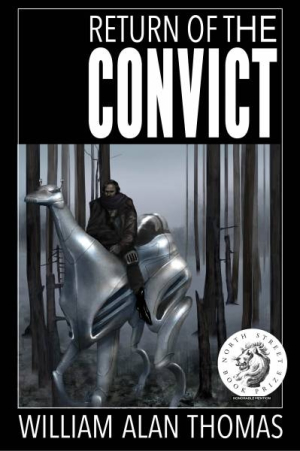Return of the Convict
The novel is in turn thrilling and thought-provoking, and has the makings of a powerful sci-fi franchise.
In the year 2143, the human struggle between individual freedom and overarching social structures still exists on Earth—at least as imagined in Return of the Convict, William Alan Thomas’s smart, sleek, and intellectually stimulating science fiction novel.
The narrative switches between the first-person account of a young aspiring space cadet, Dom Tessier, and the third-person account of his benefactor, Lucas Rivera. The latter was permanently exiled to a Martian colony, but he secretly returns to Earth to find Dom—his biological clone—and attempt a “merger” of their personalities. The characters’ interactions play out against a global technocratic government run by an elite class of telepathic citizens.
Science fiction is only as good as the imagination of its author, and Thomas delivers the goods. His 2143 is richly imagined, with enthralling detail on the material culture of a future world not unlike our own. Robotic animals called dromies transport people from place to place. “Telecaps” are placed on people’s heads to enable telepathic communication, and the most highly evolved communicators worship an omniscient quantum computer named Raina.
Differing from dystopian novels in which the world is irredeemably bleak, the futuristic society in Return of the Convict has brought the Earth back from ecological destruction and mass extinction. Interlaced with new forms of technology and architecture, such as buildings that change color with the weather, are beautiful nature preserves and recovering ecosystems.
This seeming enlightenment makes the political struggles in the novel more salient and meaningful. Bands of resisters fight the new world order. The picture of a perfect society slowly gives way to oppressive realities underneath, including a thought-controlling criminal justice system that exploits convict labor in outlying space colonies.
Moral questions of cloning, including those around the rights of human clones, echo some of the classics of literary speculative fiction, including Brave New World. The stories of George Orwell and Philip K. Dick also come to mind. The novel likewise probes questions of what it means to be human, or most precisely, what it means to be an individual in a totalitarian society.
The writing style is lean and descriptive. The science of the imaginary technologies is never overly technical, and the telepathic dialogues, offset in italics, are often poetic, especially when characters share each other’s thoughts and sensations during moments of physical intimacy. The book’s greatest weakness is its opening chapter, which is written from a future vantage point and may reveal too much too quickly about the events of the novel.
Return of the Convict forms the basis of a new series. If this entry is any indication, fans of science fiction have more to look forward to. The novel is in turn thrilling and thought-provoking, and has the makings of a powerful sci-fi franchise.
Reviewed by
Scott Neuffer
Disclosure: This article is not an endorsement, but a review. The publisher of this book provided free copies of the book and paid a small fee to have their book reviewed by a professional reviewer. Foreword Reviews and Clarion Reviews make no guarantee that the publisher will receive a positive review. Foreword Magazine, Inc. is disclosing this in accordance with the Federal Trade Commission’s 16 CFR, Part 255.

